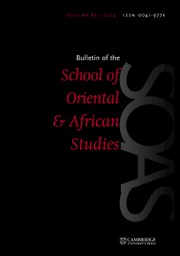The book under review is “the first comprehensive handbook of Tungusic in English” (p. xviii). Tungusic constitutes “a medium-sized language-family with some 15 different languages distributed over a vast territory in Northeast Asia” (p. 1). The forerunner of the present volume planned by Alexander Vovin over 20 years ago never appeared (p. xix). Due to the delay to the project, two sketches of Uilta and Solon intended for that volume were published independently by Toshirō Tsumagari 津曲 敏郎 in 2009 (Journal of the Graduate School of Letters 2 and 4). José Andrés Alonso de la Fuente was later invited to the project, which finally succeeded after Juha Janhunen, who had already edited the volume The Mongolic Languages in the same Routledge Language Family Series in 2003, joined the editorial team. The project was sadly overshadowed by the loss of one of the editors and two contributors: “Sasha Vovin (1961–2022) himself died only several months before the completion of the project, while Tsumagari Toshiro (1951–2020) and Daniel Kane (1948–2021) also passed away without having seen the final versions of their texts” (p. xix).
The volume contains an index (pp. 538–43) and 20 chapters that can be divided into two main parts: (1) The bulk of the volume consists of descriptions of 14 Tungusic varieties (pp. 76–500) that “follow a roughly uniform template” (p. xviii) and cover various details ranging from the research history, over phonology and grammar (e.g. converbs, person marking), to aspects of the lexicon (e.g. loanwords). These descriptions include Jurchen (Kane and Miyake, pp. 76–102), yet another sketch of Written Manchu (Vovin, pp. 103–38), Siberian Ewenki (Janhunen, pp. 139–83), Orochen (Whaley, pp. 184–205), Solon (Baek, pp. 206–33), Neghidal (Oskolskaya, pp. 234–59), Ewen (Malchukov, pp. 260–93), Oroch (Kazama, pp. 294–325), Udihe (Perekhvalskaya and Janhunen, pp. 326–63), Nanai (Kazama, pp. 364–406), Ulcha (Kazama, pp. 407–35), Uilta (Tsumagari and Yamada, pp. 436–62), Spoken Manchu (Zikmundová and Gao Wa, pp. 463–82), and Sibe (Zikmundová, pp. 483–500).
(2) The sketches are preceded (pp. 1–75) and followed (pp. 501–537) by several chapters addressing more specific topics, such as an introduction to the language family (Janhunen, pp. 1–18), an overview of “early” Chinese, Korean, and Japanese sources (Vovin, pp. 19–25), a cursory list of European sources published between 1692 and 1856 (Alonso de la Fuente, pp. 26–34), and a discussion of sociolinguistic aspects, such as the official status or endangerment (Mamontova, pp. 501–16). The chapter “Tungusic in time and space” (Janhunen, pp. 517–37) offers a contextualization of the language family (e.g. areal aspects) and potential wider connections of Tungusic (e.g. to Mongolic).
The most important contributions for the advancement of the field are perhaps the updated Proto-Tungusic reconstruction (Janhunen, pp. 35–75) as well as some of the descriptions of individual varieties previously almost exclusively accessible to readers of Russian (Ewen, Neghidal, Oroch, Uilta, Ulcha) and Chinese (Orochen, Sibe, Solon, Spoken Manchu). A strength of the volume also observed in earlier works edited by Janhunen is the strict internal consistency, including spelling and analytic conventions (e.g. Ewenki rather than Evenki, the use of the ampersand for reduplication, or boldface for forms from Written Manchu). The volume fulfils the highest standards in the field. The following is a superficial list of a few shortcomings in order of appearance that do not, however, make the book or the individual contributions less valuable as a reference work.
A chart of the Manchu script (pp. xxiv–xxvi) is missing letters as used in non-initial position. The following map (p. xxvii) shows the approximate distribution of Tungusic languages from the seventeenth to the nineteenth centuries, with only those covered in the book at hand indicated in detail. This explains the absence of languages like Arman, Bala, Chinese Kyakala, Hezhen, Kili (Kur-Urmi Nanai), Kilen, or Ussuri Nanai, but not of varieties of spoken Manchu formerly found in north-east China (e.g. Aihui) and other locations (e.g. Beijing). The sweeping condemnation of Tungusic studies in China by Janhunen as “unsophisticated” (p. 6) clearly underestimates several valuable contributions, most recently by scholars such as Cong Shan 丛珊.
The Proto-Tungusic reconstruction contains several new and intriguing proposals. Some, such as the genitive *-I (p. 58), are very plausible, while the assumption of one variable interrogative *xï(y)a(-) ~ *xa(y)ï(-) “what”, previously treated as two different stems, as well as of a “separate” Northern Tungusic *ii- “which one” (p. 60), might require more evidence to be convincing.
Regrettably, Hezhen (a southern dialect of Nanai) and Kilen (a mixed language with a southern Nanai component) – together classified as varieties of the so-called “Hezhe” language in China – are not addressed in detail in the book at hand, and the former seems to be largely neglected (pp. 3, 6, 365). These two varieties were not “first described by An Jun (1986)” (p. 366) but are also known from several earlier sources, including work done by Ling Chunsheng 凌纯声 in the 1930s. It is also incorrect that Kilen (like Kili) has a basic lexicon that “is virtually identical with that of Ewenki” (p. 365). Apart from Nanaic and Orochic elements, Kilen also contains many lexical items, including the numeral system, borrowed from Manchuric.
Without doubt, the present volume is one of the most important books ever published on Tungusic languages. It represents a true milestone in the field that will serve as an invaluable reference work for generations of scholars to come. It finally makes some of the less well-described languages accessible to general linguists and typologists. The continuing documentation and description of this “seriously endangered” (p. xviii) language family having taken a major step with the volume at hand, some of the most important tasks for Tungusic studies now are an accessible and comprehensive etymological dictionary as well as a reconstruction of the “four clearcut and internally coherent groups” (p. 8), i.e. Proto-Jurchenic (or Manchuric), Proto-Nanaic, Proto-Orochic (or Udegheic), and Proto-Ewenic.



